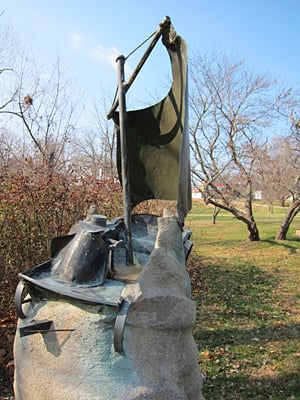Peppard’s Folly
A curious sculpture in the Kansas town that Roger Barker made his laboratory
In 1860, a drought year, Sam Peppard, a millwright in the tiny town of Oskaloosa, Kansas, decided to join the prospectors streaming toward the gold fields of Colorado. The journey was typically a hot and dusty slog of two to three months by oxcart. Peppard wanted a better way. He rigged his wooden wagon with a sail and mast, and told disbelieving townspeople that wind would whisk him across the prairies as surely as any ship on the sea.
“We had no little fun joking the teamsters as we flew by them,” he later boasted to the newspapers. But within 100 miles of Denver, a tornado struck, sucking his “wind wagon” skyward and dashing it to pieces. Though he and his three-man crew survived, the episode came to be known as Peppard’s Folly.
Whether the wind wagon was an act of genius or chutzpah is a fair question. But within a decade it didn’t matter: the newly completed Transcontinental Railroad had consigned prairie schooners to history.
I came across the tale of Peppard’s Folly while working on my Harper’s piece about Roger Barker, a maverick intellectual hired in the late 1940s to chair the psychology department at the University of Kansas. Rather than settling in the college town of Lawrence, Barker moved his family to Oskaloosa, population 725, and set about turning the town into a human observatory. He was disdainful of laboratory science, wanting instead to document the “naturally occurring behavior” of “free-ranging persons.”
Barker’s research on the interplay of environment and behavior would win some of his field’s most prestigious honors, and he is seen today as a forefather of the subdiscipline of environmental psychology. But he was a loner who took a dim view of self-promotion, and his ideas, however brilliant, were too divorced from other scholarship in psychology — or in any field, for that matter — to bring about the scientific sea change for which he had labored.
In 1980, some years after his retirement, he and his wife, Louise, hired a local artist to cast a sculpture of Peppard’s Folly. It was meant in part to celebrate their fiftieth wedding anniversary: a gift to Roger from Louise, but one they’d come up with together. Their son, Jonathan, told me that Roger visited the sculptor’s studio while the work was in progress, fascinated by the notion of a tornado rendered in concrete. At the unveiling, a reporter from the Lawrence Journal-World asked the Barkers about their choice of subject. The couple spoke of their devotion to Oskaloosa but gave few other clues.
By then, Barker’s work had not just fallen into obscurity, but had been buried by the so-called cognitive revolution in psychology. Even Barker had come to question some of his own formulations. In 1983, he wrote wistfully to a colleague about the “impermanence” of Oskaloosa’s built environment — the courthouse, schools and other “behavior settings” he’d once argued were immutable, but that were now changed or gone. “It is a wonder to me that I missed this for so long,” he wrote in the letter, which I found in Barker’s archives at the university. “How many research problems are immediately opened up!”
The sculpture, Sam Peppard and his Prairie Wind Wagon, by Matt Frazier, was first installed in a clearing in the Barkers’ backyard. But in 1990, when Roger died and Louise began making plans to leave Oskaloosa, workers hauled the one-ton structure by backhoe to Old Jefferson Town, a park off the main road where a historical society had gathered old buildings into a tourist-friendly simulacrum of an early-twentieth-century small town.
I drove to Oskaloosa from the Kansas City airport on a frigid Saturday in December, and parked my rental car in a dusty lot beside the park. Icy air was blowing off nearby farm fields. The statue stood alone at the foot of a grassy slope, next to a winding creek. A tornado, in concrete, coils up from its base. In the mouth of the vortex, in brass, a small, faceless man in hat and cape grips the steering axle as gusts engulf the wagon.
Before I arrived, I’d assumed that Peppard’s story spoke to the Barkers as a metaphor for the power of environment over behavior. But as I stood before the statue, I saw something far more personal: a tribute, and a warning, to would-be pioneers.








































































































